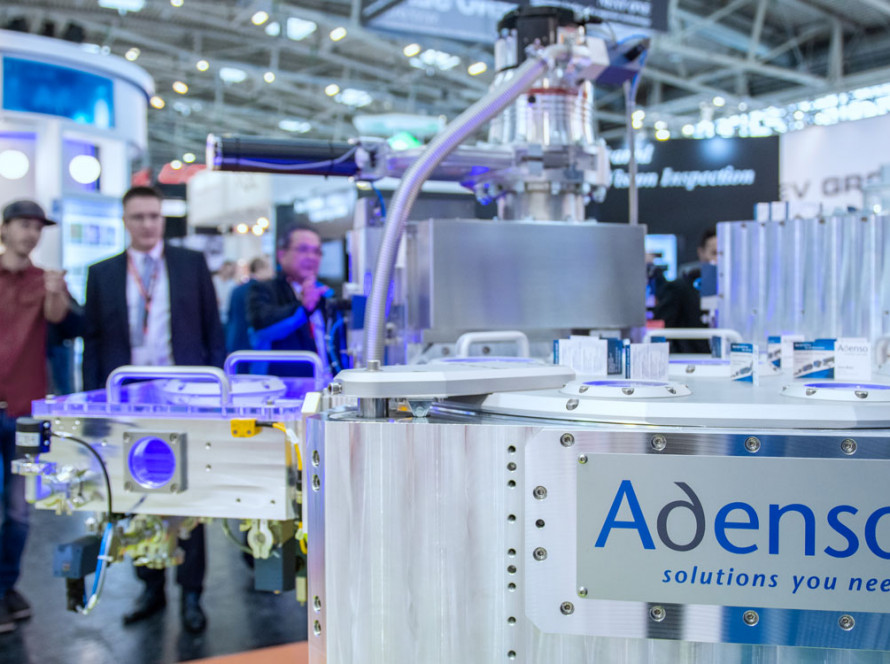After thorough preparation, the Adenso engineers have now succeeded in processing clean (!) ultra-thin glass from the roll in the high-vacuum – and without any limitations or damage. The rear laminates common to date are also no longer necessary, nor is a transport support.
Neither the process length nor the temperature or winding direction have any influence on the substrate material in the Adenso thin glass winding systems. Due to the careful handling, all process variants in any combination can be repeated as often as necessary.
Now that the thin glass substrates are currently very expensive and are therefore also hardly available, the fact that Adenso UTG modules can be used to rationally process the smallest process units of less than (!) can be significant. Very short process times are also achieved. After 40 minutes, the customer already has a usable result, whereby more than 30 (!) samples with different process parameters can be obtained from one 30m roll.
This is a milestone in many respects: It was initially used to demonstrate the process suitability of the Adenso thin glass winding mechanisms for vacuum processes (as well as atmospheric and inert gas environment). With the Adenso thin glass modules, a system suitable for industry and a compact design (footprint approx. 1sqm) became available. It is based on the Adenso R2R platform, which – technologically tested – is adapted to the respective requirements solely by customised configurations, which spares valuable resources and above all, ensures process reliability.
Furthermore, from a valuable substrate web, instead of the maximum of one parameter configuration to date, a large number of parameter variants can now be tested in different configurations – and done in unbeatably short times. Modification of the system for other processes can also be achieved easily and quickly. Thanks to the enormously high repeatability of the system, test series can be divided up in any way and continued seamlessly after days/weeks/months.
The aim for the future is now a further UTG standardisation, because respective suitable configurations of the winding system are currently required for each of the thin glass substrates of different manufacturers. This is acceptable for the current status and Adenso supports its customers with the respective setups. The Adenso UTG platform can make an important contribution to the development of this standard.
The substrate materials play a central role in this: As a tool/system manufacturer, it is Adenso’s task to find suitable solutions for the processing of customer substrates. In this early technology stage, possibilities result for contributing to the design of the thin glass manufacturing process parameters – which will be very helpful with regard to standardisation later.
Adenso UTG winding systems offer more than thin glass processes
Thin glass is “only”the supreme discipline Due to the associated extraordinary precision and dynamic, the Adenso winding mechanisms are naturally suitable for all types of substrates. For example, plastic (e.g. with 0.9µm), metal (e.g. with 5µm) or membrane films. Fabric, textiles, fibres and hollow fibres and much more are also possible.
Summary:
• The Adenso thin glass winding systems currently represent the optimum technical feasibility when it comes to ultra-thin glass processing from the roll. They form the basis for a new industry standard, which will establish itself on this.
• Adenso UTG process modules are interesting and economic for startups, universities, research institutes and production companies, which want to address the topic of ultra-thin glass processing and are looking for an entry with technological support.
• As an established network partner, Adenso supports startups/spinoffs with mit promising technology approaches through provision of thin glass technology, equipment, know-how, capital, … on a partnership basis
Adenso outlook:
For Adenso, this milestone in no way means the end of the development process. On the contrary: Due to the successful process verification, it is now possible to enter broad technology research, immediately and completely with no further obstacles, which has already been started by the initiation if numerous cooperations with universities, research facilities and industrial partners.
Process times – example calculation:
• Pumpdown: 30min / 5×10-5mbar
• Process run 1m – approx. 0.1 … 5 min
• Ventilation: 5min
= in total 40min for 1m thin glass process,
i.e. the customer has a usable result!
Your contact and expert at Adenso:
Uwe Beier, Managing Director
Tel: +49 351 79 59 79 7-70
info(at)adenso.de
Customer substrates* (alphabetical)
• Corning (USA): WILLOW GLASS – UTG 100 µm, edge protection on both sides, no rear laminate, Interleaf ILF
• NEG (JAPAN): G-LEAF – UTG 100 µm, no rear laminate, Interleaf ILF
• SCHOTT (GERMANY): UTG 100 µm, no rear laminate, Interleaf ILF
(*) these substrates were provided by customers. We rely on this information, we do not accept any liability should it contain errors.




